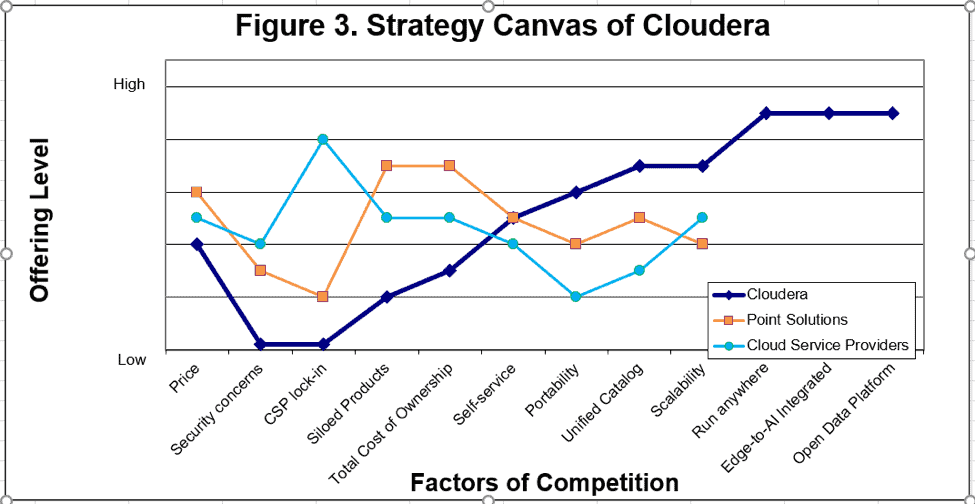Are you floundering in a Red Ocean of competition?
Modern enterprises operate in an extremely competitive (red ocean) and turbulent, hyperconnected white water world. To better appreciate the competitive environment in which your company is operating, ask yourself the following questions:
- Are you confronted with increased competition both domestically and internationally?
- Do your sales reps continually push for deeper discounts as a prerequisite to meeting sales quotas?
- Are you advertising more but getting less in return?
- Do you view outsourcing to cheaper labor markets as a key strategy to achieving competitiveness?
- Do you regard mergers and acquisitions as crucial to company growth?
- Do you find it easier to obtain funding for responding to strategic moves of your rivals than to obtain internal funding for a strategic move that would enable your company to break away from your competitors?
- Are you frequently concerned about commoditization of your offerings?
- When you compare your competitive advantages with those of your rivals, do they look surprisingly similar?
If you realize that you’re answering “yes” to these types of questions, then your company is undoubtedly treading water in an existing, highly competitive “red ocean” market space with a focus on beating your rivals, exploiting existing demand, and making the value/cost tradeoff.
The “Blue Ocean” alternative
A “blue ocean” strategy offers a compelling alternative to traditional assumptions about competitive advantage. It represents a shift in thinking about competing in an existing market space (red ocean) to thinking about finding, developing, exploiting, and protecting a new market space (blue ocean). The successful outcome is creation of uncontested market space – built around new product attributes – which renders the “competition” irrelevant, creating and capturing new demand in contrast to exploiting and competing over existing demand, and breaking (rather than making) the value/cost tradeoff
Six principles of Blue Ocean strategy ( Kim and Mauborgne, 2017, Blue Ocean Strategy) guide companies in minimizing (rather than taking) risks and maximizing opportunity by addressing the following six key areas of risk associated with adopting a blue ocean strategy: search, planning, scope, business model, organization, and management.
- Reconstruct market boundaries – addresses how to successfully identify commercially feasible blue ocean opportunities.
- Focus on the big picture rather than the numbers – addresses mitigation of planning risk associated with significant investments in time and effort with the potential of delivering only tactical red-ocean moves.
- Reach beyond existing demand – addresses the scope risk of aggregating the greatest demand for a new offering.
- Get the strategic sequence right – addresses how to build a robust business model to ensure that you make healthy profit on your blue ocean idea, thereby mitigating business model risk.
- Overcome key organizational hurdles – tackles how to overcome organizational hurdles in executing a blue-ocean strategy.
- Build execution into strategy – tackles how to motivate people to execute blue-ocean strategy to the best of their abilities.
Key analytical tools to assist enterprises in developing their blue ocean strategies are introduced below. Cloudera’s application of these tools within the Data Management and Analytics market is presented as an example of how a company can use the tools to guide it in formulating its blue ocean strategy.
Analytical Tools
The Strategy Canvas (incorporating value curves) and Four Actions Framework are important analytical tools for value innovation and creation of blue oceans.
Strategy Canvas and Value Curves
The strategy canvas, illustrated in Figure 1 for the Data Management and Analytics market from Cloudera’s perspective, is a diagnostic chart that captures the present state of play in the known market space. It provides insight into (1) where the competition is investing, (2) factors on which the industry is competing in products, service, and delivery, and (3) how customers are benefiting from competitive offerings in the market. The horizontal axis of the Strategy Canvas represents the range of principal factors targeted for competition and investment by the industry. The vertical axis represents the relative offering levels that buyers receive across all the key factors of competition; the higher the offering level, the more the company (or industry segment) is offering to buyers and hence the more the company is investing. Note that, to influence a shift in the strategy canvas of an industry, you must start by reorienting your strategic focus from competitors to alternatives and from customers to noncustomers of the industry.
The value curve – the basic component of a strategy canvas – is a graphical representation of the strategic profile of a company or industry segment reflecting its relative performance across the industry’s factors of competition. When representing an industry segment, the value curve depicts multiple companies that have converged on a common strategic profile; from a marketing perspective, these companies are all different in the same way. Two industry segments are represented in Figure 1; (1) Point Solutions are product specialization offerings to meet specific workloads in data management & analytics such as Data Warehouse, Data Science/Machine Learning, and Operational Database; (2) Cloud Service Providers represents data management & analytics offerings from Cloud platform vendors. (Note that the strategic profiles represented for these two industry segments reflect approximations).

Four Actions Framework
The Four Actions Framework, depicted in Figure 2 for Cloudera, is used to reconstruct buyer value elements in crafting a new value curve in pursuit of a blue ocean strategy. The framework incorporates the actions described below.
- Eliminate – Decide which factors taken for granted by the industry should be eliminated.
- Reduce – Decide which factors should be reduced well below the industry’s standard (customers are being overserved, increasing cost structure for no gain).
- Raise – Decide which factors should be raised well above the industry’s standard.
- Create – Decide which factors not currently offered by the industry should be created (discover new sources of value for buyers, create new demand, shift strategic pricing of the industry).
Figure 2. Four Actions Framework for Cloudera
Eliminate
|
Raise
|
Reduce
|
Create
|
The factors listed under Eliminate, Reduce and Raise in Figure 2 are red-ocean considerations that are adjusted accordingly to differentiate Cloudera from its competitors. The factors listed under Create are new attributes that define the newly created, uncontested market space of the blue ocean; protecting this new market space should be an important consideration of a company’s blue ocean strategy.
Cloudera’s new value curve
Enterprises are demanding a modern analytic experience across public, private, hybrid and multicloud environments. They need the agility, elasticity, and ease of use associated with cloud infrastructure as well as the ability to run analytic workloads wherever they choose, regardless of where their data may reside. They want open architectures and the flexibility to move those workloads to different cloud environments, public or private, to avoid vendor lock-in. They need the ability to run multiple analytic functions on the same data set with a common security and governance framework, enabling data privacy and regulatory compliance. Addressing real world business problems like the examples outlined below requires the application of multiple analytic functions working together on the same data, i.e., a connected data strategy:
- Connected and autonomous vehicles that require the application of both real-time data streaming and machine learning algorithms
- Optimization of 5G networks to increase capacity and satisfy regulators, whether for AML, fraud, risk modeling or privacy
The answer to enterprises’ needs and demands outlined above is Enterprise Data Cloud, a new market niche that Cloudera is uniquely positioned to fill based on its new value curve depicted in Figure 3. Cloudera’s value curve clearly diverges from those of its competitors (Point Solutions and Cloud Service Providers) due to elimination of security concerns and Cloud Service Provider (CSP) lock-in, significant reduction in siloed products and TCO, significant increase in portability, unified catalog and scalability, and creation of run anywhere, Edge-to-AI and open data platform factors. Table 1 elaborates on Cloudera’s approach to Factors of Competition represented in its strategy canvas.
Cloudera’s new value curve epitomizes three characteristics of a good blue ocean strategy; focus as reflected in higher offering levels, divergence in the shape of the value curve relative to that of competitors, and a compelling tagline reflected in new factors created.

Table 1. Cloudera’s Approach to Factors of Competition
| Factor of Competition | Cloudera’s Approach |
| Security concerns | Cloudera’s strategy eliminates costs and risks associated with non-centralized security, governance, and risk control |
| CSP lock-in | Cloudera’s strategy eliminates Cloud Service Provider (CSP) lock-in by delivering true hybrid capability with support for public cloud, private cloud, multi-cloud, and on-premises deployments. Cloudera’s offerings are built on open source components. |
| Siloed Products | Cloudera’s unified, multi-function platform strategy reduces the product silos and corresponding integration issues |
| Total Cost of Ownership | Cloudera strategy delivers an integrated suite of data management and analytics tools in a single platform, making it more cost effective to deliver complex, multiple use cases and thus reduce TCO |
| Self-service | Cloudera’s strategy enables self-service experiences ranging from management to user’s ease-of-access to data |
| Unified Catalog | Cloudera’s strategy incorporates a Shared Data Experience (SDX) that enables you to bring your choice of workload to the data with a unified catalog that bridges the most complex environment and ensures consistent security and granular governance. |
| Run anywhere | Cloudera’s strategy provides ultimate flexibility for infrastructure, storage, and compute resources. You can operate anywhere, using any public cloud or private enterprise infrastructure. Cloudera offers a unified control plane (single pane of glass) for orchestration and management and a shared data experience across hybrid environments. |
| Edge-to-AI Integrated | Ingest at-the-edge to AI-powered operations all in a single data management platform, spanning the range from capturing and analyzing streaming data at the edge – to storing, transforming, accessing, and modeling historical data – to building, training, and deploying machine learning models at scale. |
| Open Data Platform | Cloudera’s strategy enables 100% open data platform; open source, open storage, and open for integration. |
The competitive environment in which modern enterprises operate compels them to scrutinize where they are allocating budget and resources and whether this allocation is paying off. It should motivate them to seek, develop and protect new, uncontested markets that will render the competition irrelevant, hence creating a new competitive advantage. Where is your Blue Ocean?
Understand Cloudera’s Strategy by learning about the Enterprise Data Cloud
About the Author:
Lakshmi Randall is Director of Product Marketing at Cloudera, the enterprise data cloud company. Previously, she was a Research Director at Gartner (News – Alert) covering Data Warehousing, Data Integration, Big Data, Information Management, and Analytics practices. To learn more, visit www.cloudera.com or follow the company @cloudera or the author on Twitter (News – Alert): @LakshmiLJ



